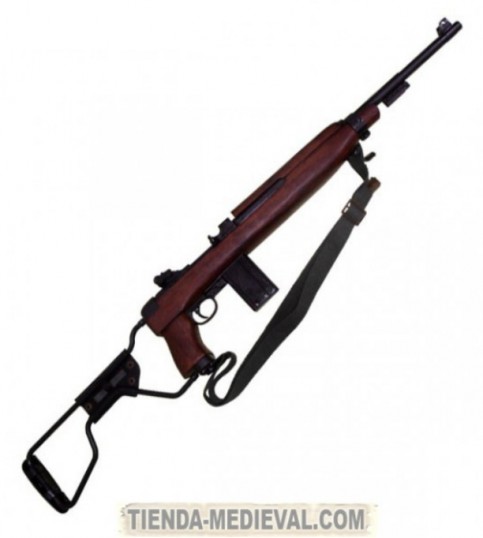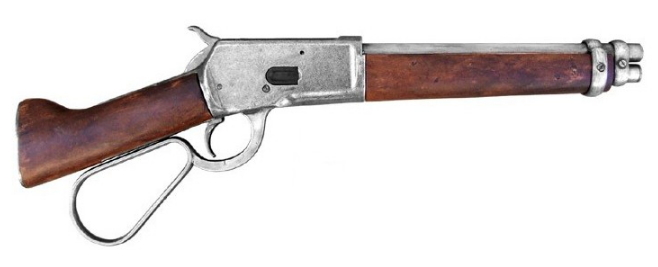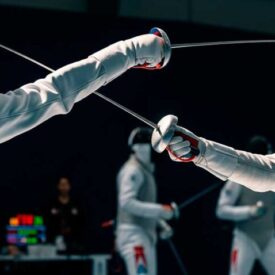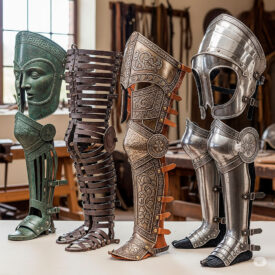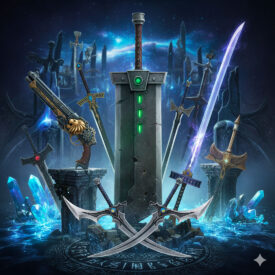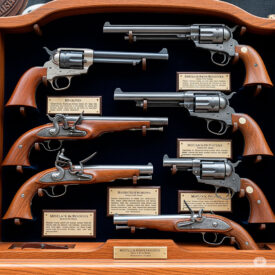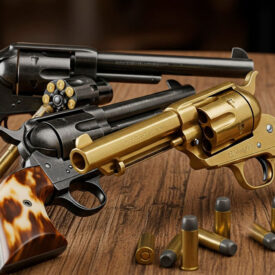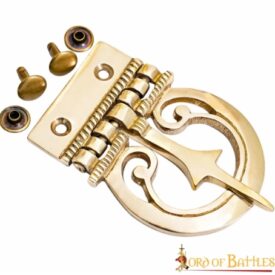Collecting weapons has been, throughout history, much more than just a hobby; it is a way to connect with the past, appreciate the engineering of bygone eras, and own pieces that evoke great moments. Decorative rifles, in particular, offer this possibility without the complexities and responsibilities associated with functional firearms. They are objects that capture the essence of power and precision, transformed into authentic works of art and historical elements. These meticulously crafted replicas allow enthusiasts and collectors to immerse themselves in the rich narrative of humanity, from ancient battles to modern conflicts, without the security or legal implications of real weapons.
These are decorative but non-functional replicas. They are beautiful pieces, very faithful to the originals, designed to be displayed and admired for their aesthetic and historical value. Their appeal lies in their ability to evoke significant eras and events, becoming focal points of any collection or decor.
The rifle is a type of long gun, encompassing rifles and carbines, and is fundamentally characterized by having a barrel with a rifled or grooved bore. This internal rifling, known as helical rifling, is crucial for stabilizing the bullet during firing. As the bullet travels down the barrel, it acquires a rotational movement on its own axis, behaving like a gyroscope. This gyroscopic effect is what gives it greater accuracy and range, preventing the bullet from being significantly deflected by external factors such as crosswinds. Historically, rifles have been fundamental tools in hunting, warfare, and sport, evolving from the earliest muzzle-loading models to today’s sophisticated semi-automatic and assault weapons. Decorative replicas capture this evolution, offering a window into the engineering and design of each period.
A Journey Through History: The Essence of Replicas
Replicas of historical weapons invite us on a fascinating journey through time, allowing us to touch and feel history. Specialized companies in this field, such as DENIX, were born from the initiative of founders with deep experience in jewelry making, a traditional sector that provided them with artisanal knowledge, attention to detail, and the tenacity to create high-quality replicas. Their activity began in Ciutadella de Menorca in 1967, with a clear vision: to transform historical objects into accessible pieces for collecting and decoration.
From their humble beginnings, these companies have expanded their vision, diversifying their catalogs to recreate weapons that were protagonists of key events and eras in human history. Their commitment to historical authenticity and detail has allowed collectors worldwide to access replicas that are true works of art and testimony to the evolution of weaponry. The catalog of replicas is vast and covers countless periods and cultures:
- Antiquity: Replicas of weapons that defined conflicts in the Mediterranean, Middle East, and Asia, from Roman swords to Greek armor and Oriental daggers.
- Medieval Europe: Pieces that evoke the era of knights, castles, and crusades, including two-handed swords, battle axes, and shields.
- European Colonial Expansion: Weapons that sailed on explorers’ caravels and were used by pirates and privateers in their maritime adventures, such as arquebuses, blunderbusses, and sabers.
- American Civil War and the Conquest of the West: Iconic rifles and revolvers that defined one of the most legendary eras in U.S. history, such as the famous Winchester and Colt.
- World Wars and the 20th Century: Weapons that marked recent history, from World War I rifles to submachine guns and assault rifles of World War II and later conflicts.
Each piece is a small moment of history, designed so that collectors can enjoy and treasure them in their homes, personal museums, or as educational elements. Realism and historical content are fundamental for collectors and enthusiasts, who seek in these replicas not just an object, but a tangible connection to the past. Replicas are aimed at a very specific audience that demands pieces for their historical or decorative value, and even to be used as props in theater, film, or television productions, where visual authenticity is paramount.
The term “fusil” is of French origin and refers to a portable long-barreled firearm designed to shoot bullets over long distances. Created for offensive purposes, it has been the most widely used personal weapon in armies since the late 17th century. Originally, it was customary to attach a bayonet for close combat, a practice that is now largely obsolete due to the evolution of military tactics and weaponry. The name “fusil” comes from the evolution of the musket, which abandoned the matchlock in favor of flint for ignition. As the length of fusils decreased, their designation changed, with the carbine being a shorter and lighter version, ideal for cavalry or troops requiring greater mobility. Replicas of fusils and carbines are especially popular, as they represent the backbone of military weaponry throughout the centuries.
Definition and Key Features of Each Type of Replicated Weapon
Although the original article mentioned “knives,” in the context of decorative rifles, it is crucial to understand the differences between the types of long firearms that are replicated. Each has distinctive features that made them unique in their time and are reflected in the replicas:
- Rifle: As already mentioned, its main feature is the rifled bore to stabilize the bullet. Rifles are known for their long-range accuracy. In collecting, hunting rifles, military sniper rifles, and Old West lever-action rifles are replicated. Replicas often stand out for their length and the fidelity of the loading mechanism and barrel details.
- Fusil: A more generic term for long-barreled infantry weapons. Historically, fusils evolved from muzzleloaders to breechloaders, and from matchlock to flintlock, then to percussion systems. Fusil replicas often represent the standard models of armies from different eras, such as Napoleonic flintlock fusils or bolt-action fusils from the world wars. They are usually robust and large pieces.
- Carbine: A shorter and lighter version of the fusil or rifle, designed to be more manageable, especially in confined spaces or for mounted troops. Carbines sacrifice some range and accuracy for portability. Carbine replicas are popular for their compact size, making them ideal for display in smaller spaces, and for their association with elite or cavalry units.
- Mosquetón (Short Rifle): Although colloquially used for bolt-action weapons shorter than the fusil (such as the Coruña model), historically a mosquetón was a single-shot, smoothbore weapon, shorter than a musket, used by cavalry or light troops. Replicas of old mosquetóns are valuable for representing a type of weapon that marked the transition between muskets and more modern fusils.
The distinction between these types of weapons in their decorative versions lies in the fidelity with which their original features are reproduced, allowing the collector to appreciate the evolution of design and function throughout history.
Manufacturing and Realism: What Are Decorative Rifles Really?
From a technical point of view, decorative rifles are pieces made for purely aesthetic and ornamental purposes. Unlike real firearms, they have no firing capability or authentic functionality. This means they cannot load or fire projectiles, and their internal mechanisms, if present, are purely ornamental and not designed to operate as a real weapon. The materials used in their manufacture are not the same as those of a real weapon; for example, they are not always made of steel resistant to firing pressures, but may use lighter and more economical metal alloys, or even polymers and treated woods to achieve the desired appearance.
The manufacture of these replicas requires a high level of detail and strict compliance with safety and legal regulations. Companies such as DENIX, world leaders in the sector, ensure that their replicas are faithful in appearance and safe to handle, rigorously complying with European and international regulations. Their production process is a testament to their commitment to excellence: they have factories of over 3,500 m² equipped with state-of-the-art technology and teams dedicated to quality, productivity, and occupational safety. This comprehensive approach guarantees an excellent final product that is not only visually impressive but also safe for the collector.
Constant innovation is key for these companies, which seek to continuously improve product quality and adapt to the diverse preferences of collectors in different markets. This includes researching new materials and finishing techniques to achieve even greater realism, as well as expanding their catalog to include replicas of less common or more in-demand historical period weapons.
In addition to their inherent value for collecting and home decoration, decorative rifles have many practical uses. They are exceptional gifts for history lovers, military enthusiasts, or movie buffs. They are also widely used as props in film and theater productions, where their visual realism is fundamental for setting historical or action scenes. Their use in historical reenactment events is equally popular, where they are often combined with blank-firing weapons to safely and controllably simulate firing effects, adding a layer of authenticity to performances.
In Spain, the word “mosquetón” is also used for bolt-action weapons shorter than the fusil, such as the Coruña model. This meaning has become accepted through popular usage, although, as mentioned, a mosquetón is actually a single-shot, smoothbore weapon, like those used, for example, in the Napoleonic wars. This duality in terminology highlights the rich and sometimes confusing evolution of weaponry throughout history.
The Legal Framework in Spain: Understanding the Differences and Avoiding Risks
A crucial and often misunderstood aspect for any weapon collector, whether real or replica, is understanding the legal status of these pieces. In Spain, the Weapons Regulation establishes clear distinctions that are fundamental to avoiding legal problems. It is vital not to confuse decorative weapons with other categories that, although they may seem similar, have very different legal implications:
- Decorative Weapons (Replicas): These are pieces made from scratch for purely aesthetic and ornamental purposes. Their design does not include the ability to fire or to be easily converted into functional weapons. Since they are not technically considered real firearms, the Spanish Weapons Regulation exempts them from classification and, in general, they can be owned without a license. However, it is important to be prudent: if their realism is extreme and they can easily be mistaken for a real weapon in a public context, they may be subject to inspection or to regulations on objects that may cause public alarm. The key here is their intrinsic inability to be used as a firearm.
- Deactivated Weapons: These are real firearms that have been irreversibly modified so they cannot fire. This deactivation process must be certified by an authorized official proof house, following specific and rigorous technical requirements (such as cutting the barrel lengthwise, blocking the firing mechanism, or filling the chamber). Although once deactivated they do not require a weapons license for possession, they do require registration and traceability, and the owner must be identified and the deactivation properly documented. If you try to sell, transport, or display a deactivated weapon without the proper documentation certifying its legal deactivation, serious legal problems may arise. These are pieces that were functional and, by law, must be recognized as such, even if they are no longer so.
- Unusable Weapons (or “Deteriorated Firearms”): This term is colloquially used to refer to weapons that, due to their deteriorated state (rusty, broken, incomplete, with damaged mechanisms), cannot fire in their current condition. However, and here lies the legal trap, if they have not undergone the official deactivation and certification process by a proof house, they are still legally considered functional firearms. Possession without the corresponding permits (weapons licenses, ownership guides) is illegal and can result in severe penalties, including heavy fines and prison sentences. This category often includes inherited old weapons that seem unusable but have not been regularized, representing a considerable legal risk for their owners.
It is essential to understand that, for the law, what matters is not just the visual appearance of an object, but its administrative and technical status. Even if a “replica” lacks a barrel or bolt, certain parts may be considered “essential components” of a firearm, and their import or possession without a license can be problematic in Spain, even if legal in other countries. Weapons legislation is complex and designed to ensure public safety. In case of doubt, the recommendation is always to consult directly with the Weapons and Explosives Intervention of the Guardia Civil, which is the competent authority to clarify any situation and provide the most up-to-date and accurate information.
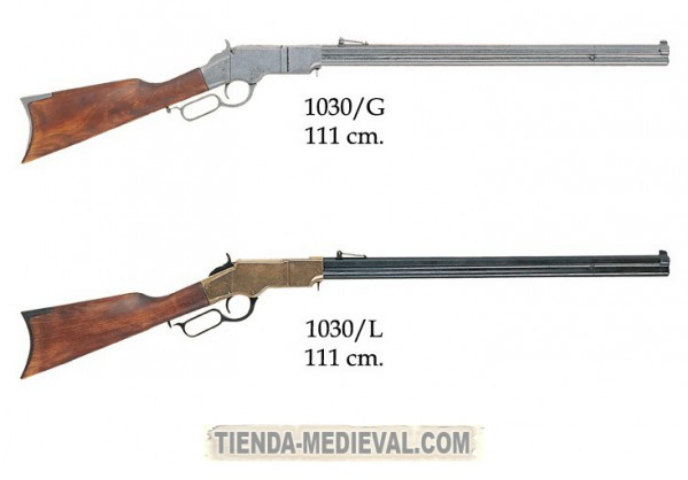
Practical and Technical Differences in Replicas
Although all pieces are decorative, replicas of rifles, fusils, and carbines present practical and technical differences that make them unique and attractive to different types of collectors. These differences derive from the characteristics of the original weapons they replicate:
- Size and Weight: Fusil replicas are usually the longest and heaviest, making them imposing as display pieces. Carbines, being shorter, are easier to handle and display in confined spaces. Replicated sniper rifles can be long, but their design focuses on the visual precision of their sights and mechanisms.
- Recreated Mechanisms: Many high-quality replicas, such as those from DENIX, include moving mechanisms that mimic the action of real weapons (for example, the bolt of a rifle, the hammer of a revolver, or the trigger). Although not functional, the ability to manipulate these elements adds a level of realism and satisfaction for the collector.
- Materials and Finishes: While they do not use the same ballistic steels, quality replicas use metal alloys and woods that faithfully imitate the original materials. Finishes may include aging, bluing, or polishing that replicate the look of historical weapons, sometimes with authentic markings and engravings.
- Historical Detail: Precision in historical details is a key difference. Some replicas focus on iconic models, while others reproduce specific versions of a weapon used in a conflict or by a particular historical figure. This level of detail is crucial for collectors with a deep historical interest.
Ideal Use Scenarios for Each Type of Replica
Decorative rifle replicas are not just for display; their versatility allows them to fit into various scenarios:
- Home or Office Decoration: An Old West Winchester rifle can be the centerpiece in a themed study, while a World War I fusil can complement a library with military history books. They are pieces that add character and a touch of history to any environment.
- Themed Collecting: Collectors can specialize in a period (e.g., the American Civil War), a type of weapon (e.g., lever-action rifles), or even weapons associated with historical figures. Replicas allow for building a diverse and visually impactful collection.
- Props and Historical Reenactment: Their realism makes them the perfect prop for film, television, or theater productions, where safety is paramount but visual authenticity cannot be sacrificed. In historical reenactment events, replicas are essential for outfitting characters and scenes, often combined with blank-firing weapons for sound effects.
- Education and Museography: They are excellent tools for teaching history, allowing students and museum visitors to interact (safely) with replicas of weapons that defined eras. They help understand technological evolution and the impact of weapons on society.
- Gifts and Souvenirs: For history enthusiasts or weapon aficionados, a quality replica is a unique and memorable gift that combines art, history, and a touch of adventure.
Comparison of Advantages and Disadvantages of Collecting Replicas
Collecting decorative rifle replicas offers a number of distinctive advantages, but also presents some considerations:
Advantages:
- Safety: Since they are not functional, replicas eliminate the risks associated with handling real firearms, making them safe for home display and handling by collectors of all ages (always with supervision for the youngest).
- Legality and Accessibility: In most countries, including Spain, decorative replicas are not subject to the strict licensing, registration, and storage regulations of real firearms. This makes them much more accessible to the general public.
- Historical and Artistic Preservation: They allow you to own and appreciate pieces that would otherwise be inaccessible (due to rarity, cost, or legal status). They are a way to keep the history and engineering of past eras alive.
- Cost-Effectiveness: Generally, replicas are significantly more affordable than original antique weapons or legally deactivated weapons, allowing collectors to build a broader and more diverse collection on a limited budget.
- Versatility of Use: As mentioned, they can be used for decoration, props, education, or simply as objects of personal admiration.
- No Complex Maintenance: Unlike functional weapons that require specific cleaning and maintenance, replicas only need basic care to maintain their appearance.
Disadvantages:
- Lack of Functionality: For those seeking the full experience of a firearm, the lack of functionality in replicas can be a drawback. However, this is precisely their purpose: to be decorative and safe.
- Potential for Confusion: If the realism is extreme and the replica is displayed or transported irresponsibly in a public place, it could be mistaken for a real weapon, which could cause alarm and problems with authorities. It is crucial to use common sense and discretion.
- Not Investments: Unlike original antique weapons, which may appreciate over time, decorative replicas are rarely considered a financial investment. Their value is mainly aesthetic, historical, and personal.
- Material Limitations: Although high quality, the materials of replicas may not be as durable or resistant as those of real weapons, which is a consideration if handled frequently.
Purchase and Use Recommendations According to User Profile
The world of replica collecting is vast and offers options for everyone. Here are some recommendations according to the collector’s profile:
- For Beginners and Occasional Enthusiasts:
- Start with the Iconic: Opt for replicas of famous and recognizable weapons, such as an Old West Winchester rifle, a Colt Peacemaker revolver, or a World War II fusil. These are pieces with great visual and narrative appeal.
- Prioritize Quality and Safety: Always buy from reputable manufacturers and distributors, such as DENIX. Make sure the replica complies with safety regulations and that its inability to fire is evident.
- Consider Space: If your space is limited, a carbine or revolver may be more suitable than a long fusil.
- Learn the Law: Although replicas are usually legal, familiarize yourself with local regulations regarding their display or transport.
- For the Experienced Collector:
- Seek Historical Accuracy: Focus on replicas that reproduce specific models as faithfully as possible, with authentic details and high-quality finishes.
- Explore Niches: Consider collecting weapons from less common historical periods or specific conflicts, which can lead to rarer and more unique pieces.
- Attention to Detail: Value moving mechanisms, engravings, stock and grip materials, and the authenticity of markings.
- Curate the Collection: Think about how each new piece fits into your existing collection, creating a coherent narrative or theme.
- For the Occasional Adventurer and Themed Decor Lover:
- Style Over Absolute Accuracy: If the main goal is decoration, you can prioritize the visual impact and style the replica brings to a space, without needing to be an expert in every historical detail.
- Versatile Pieces: A lever-action rifle can fit both a rustic environment and a more modern one with industrial touches.
- Gifts with History: A well-chosen replica is a gift that tells a story and will be appreciated for its uniqueness.
Collecting antique weapons, whether legally deactivated or decorative replicas, has great aesthetic and historical value. For history lovers and reenactors, these pieces offer the opportunity to own a tangible piece of the past safely and legally, as long as current regulations are understood and respected. Dive into this fascinating world and find the piece that best suits your passion for history and art.

